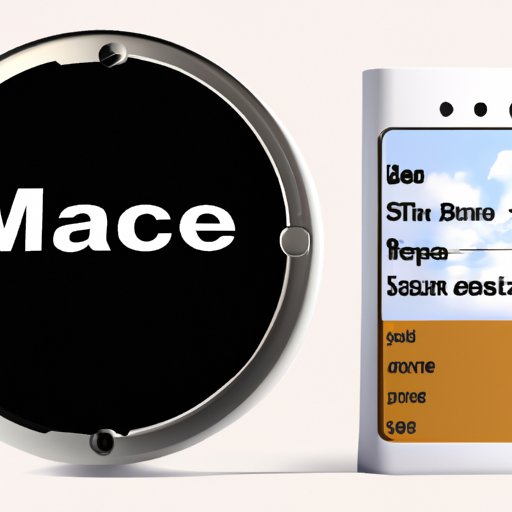
Introduction
Running out of space can be a major problem for users of Mac computers. Whether it’s for work, personal files, or multimedia content, the more we use our Macs, the more cluttered and disorganised they can become over time. However, there are several relatively simple ways to free up space on a Mac, which this article aims to explore in a comprehensive and user-friendly way.
Here are five easy ways to free up more space on your Mac:
Clean up your hard drive
One of the most effective ways to free up space on your Mac is to clean up your hard drive. This involves deleting any old or unused files and folders that are taking up precious storage space. Some of the types of files you may want to consider deleting include:
- Old backups of your iOS devices
- Old emails or email attachments
- Duplicate files or folders
- Large files like movies, music or photos
To delete these files manually, you can start by using Finder. Simply select the files or folders you want to delete by clicking on them, then right-click and select “Move to Trash”. Once you’ve selected all the files you want to delete, you can then empty the Trash by right-clicking on the Trash icon in your Dock and selecting “Empty Trash”.
You can also use third-party cleaning utilities like CleanMyMac or OnyX to clean up your hard drive more efficiently. These tools essentially do the job of deleting old and unnecessary files for you, leaving you with more free space on your Mac. Both CleanMyMac and OnyX have free trial versions available online and are easy to use even for the least tech-savvy Mac users.
Uninstall unneeded apps
Much like deleting old files, uninstalling unneeded apps is also a useful way to free up space on your Mac. Despite being relatively small in size, apps can often take up more space than you realise, especially if they have associated files or caches. To uninstall an app using Launchpad, follow these steps:
- Go to Launchpad in your Dock
- Find the app you want to uninstall
- Click and hold on the app icon until it starts shaking and displays an “X” icon
- Click on the “X” icon to uninstall the app
Alternatively, you can use third-party app cleaner tools like AppCleaner to remove all associated files and caches that come with an app. Simply drag and drop the app you want to uninstall into the AppCleaner interface, and the tool will take care of the rest.
It’s worth noting that the space-saving benefits of uninstalling apps can be maximised by also deleting any associated files or caches. This may require more advanced knowledge of where to find these files but could potentially free up even more space on your Mac.
Use cloud storage
Cloud storage is becoming an increasingly popular way to free up local storage on your Mac. The basic idea is to store your files remotely on a server that can be accessed from anywhere with an internet connection. Three of the most popular cloud storage services are Dropbox, Google Drive, and iCloud.
The benefits of using cloud storage include being able to access your files from anywhere, easily sharing files with others, and being able to keep important files safe even if your Mac is lost or stolen. To use cloud storage, you can start by creating an account with the service of your choice and downloading the relevant Mac app.
Once you have downloaded the app, you can then drag and drop files from your computer into the cloud folder to make sure that they’re always backed up. You can also access your files in the cloud folder from any other device with an internet connection.
Delete unwanted downloads
Just like old files and apps, unwanted downloads can pile up over time and take up valuable space on your Mac. To delete unneeded downloads, you can start by opening Finder and navigating to your Downloads folder. From there, you can select any unwanted files and delete them by dragging them to the Trash.
It’s worth noting that downloads can take up a lot of space because they’re often large files like videos, music or even software updates. That’s why it’s important to regularly review your downloads folder and delete anything that’s no longer needed.
Optimise storage
Finally, MacOS has a built-in feature called “Optimise Storage” that can help free up space on your Mac. This feature automatically removes movies and TV shows you’ve already watched from iTunes and empties the Trash automatically. It also stores your files in iCloud and makes them available on demand, freeing up storage space on your Mac.
To activate the feature, follow these steps:
- Click on the Apple menu
- Go to About This Mac and click on Storage
- Click on the “Manage” button
- Select “Optimised Storage”
It’s important to note that using “Optimise Storage” may require a paid iCloud subscription and could cause some of your files to be unavailable offline. However, for many users, the trade-offs may be worth it for the extra space gained.
Conclusion
Freeing up space on your Mac is a crucial part of keeping your computer running smoothly and efficiently. By cleaning up your hard drive, uninstalling unneeded apps, using cloud storage, deleting unwanted downloads, and optimising your storage, you can free up as much space as possible and avoid running out of space in the future.
Whether you’re a new Mac user or have been using Apple products for years, implementing these tips will help to ensure that your computer stays organised and efficient, allowing you to focus on your work and creative pursuits.
If you’re still struggling to free up space on your Mac, don’t hesitate to reach out to a specialist or browse online for more tips and resources.




